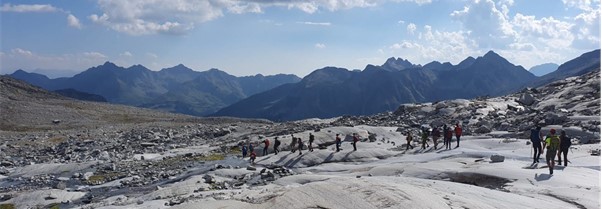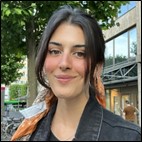
EAG Sponsored student Fernanda Torres García reports back from the 6th EGU Summer School

Owing to the COVID-pandemic the EGU Summer School last took place in 2019, so once I learned that it was going to be organised again in the summer of 2023, I started preparing my field gear! The Summer School was held in Brunico (Italy) and consisted of a workshop which integrated field-based observations of magmatic rocks and deformation processes with lectures. The field-based part of the Summer School took place on the extraordinary well-exposed Nevessee area, where glacially polished exposures are incredible and provide a natural laboratory for field training to study petrogenetic and deformation processes. The area hosts an impressive variety of mesoscale structures, with notable examples of multiphase magmatic intrusion, magma mingling structures, localization of ductile shear zones and their interaction.
Attending the EGU Summer School was an amazing experience for me in several ways. We spent the first days looking at field evidence for the timing relationships between the different intrusions, the role of fluids during ductile deformation, and the kinematic relationships between the different structural element of the deformation network (shear zones and veins). We were very encouraged to make observations and engage in scientific discussions with the professors and other students. The following days of lectures included topics such as finite element and numerical modelling, fluid-rock interaction, geochemical processes on strain localization, mechanisms of formation of crystallographic preferred orientation in Earth’s materials and structural data analysis from photogrammetric outcrop models. We had the opportunity not only to learn how to better describe and characterize heterogeneously deformed magmatic rocks, but also how to apply micro-analytical techniques of quantitative structural analysis, and how to couple these techniques with the micro-geochemistry, petrology, and geochronology.


We were also encouraged to present our research and projects in informal poster sessions after the lectures. Through my attendance at the Summer School I was able to expand my network, improve my presentation skills and effectively share my research and receive feedback on it. This was very inspiring and gave me confidence in my own research and capabilities. It was also an excellent opportunity to meet researchers from different backgrounds and at different stages of their academic career.
It is not every day that you are you fortunate enough to hike up the Italian Alps, stay in a mountain hut and learn from experts in different fields. I would like to thank the EAG student sponsorship bursary for giving me the opportunity to attend the Sixth EGU Summer School, which would have not been possible otherwise. Thank you for supporting this astounding adventure! The combination of geology and hiking in the Alps was a unique and enriching personal experience.


As advice for my fellow PhD colleagues planning to attend the next edition of the EGU summer school, if possible, you should definitely go. As for every field, I suggest preparing for the all the seasons, as weather changes rapidly in the mountains and enjoy the amazing views of the Alps!

